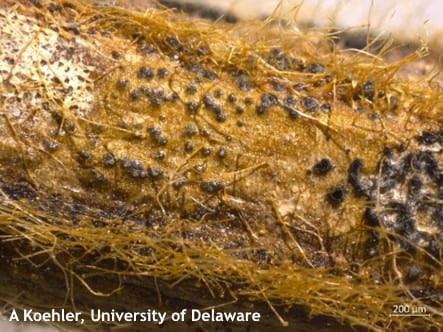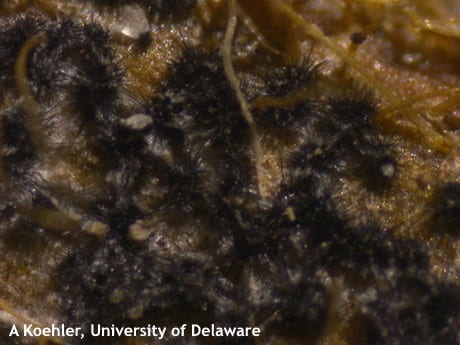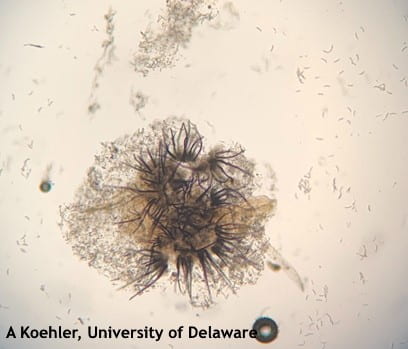Alyssa Koehler, Extension Field Crops Pathologist; akoehler@udel.edu
Full season soybeans across the area are approaching R1-R3. Overall, the heat of the past few weeks has kept disease pressure low across the region. There have been a few reports of low canopy Septoria Brown Spot (Figure 1), which does typically effect yield. There have also been a few cases of Anthracnose caused by Colletotrichum truncatum and other Colletotrichum sp. This fungal pathogen causes irregular black spots present on the stem, pods, or petioles (Figure 2). If you zoom in on the black zones, you will see acervuli that resemble pincushions with many needle-like or eyelash structures called setae (Figure 3). These structures produce conidia that spread the disease. Another disease, pod and Stem blight, will also have black structures visible on the stem, but these are typically in straight lines and are most visible from R6 to R8. It is possible to have both diseases present on the same plant late in the season.
Figure 1. Low canopy Septoria brown spot
Figure 2. Soybean Anthracnose
Fungicide applications are typically most economical when disease is present and fungicides are applied during R1-R6 growth stages, with R3 being the most common timing. If you have disease present, and are considering a fungicide application, it is important to scout fields and monitor the weather. Most soybean diseases are favored by humid, wet conditions. If weather patterns continue to be hot and dry, disease pressure will likely remain low. However, as we have seen in wet years, frequent rainfall can lead to serious late season disease issues, so continue to monitor rainfall and disease pressure through R6.
Figure 3. Anthracnose Setae: top, zoomed in view of acervuli with needle-like setae; bottom, setae under the magnification of a microscope
The 2020 National Fungicide Efficacy Recommendations for Foliar Diseases of Soybean can be found at https://crop-protection-network.s3.amazonaws.com/publications/fungicide-efficacy-for-control-of-soybean-foliar-diseases-filename-2020-03-18-150123.pdf. In 2019, a soybean foliar fungicide efficacy trial was conducted at the Carvel Research and Education Center. Disease pressure remained low in 2019 and there were no ratable levels of foliar pathogens present. Results are included here and can also be found at https://sites.udel.edu/canr-koehlerlab/research/soybeans/2019-soybean-fungicide-efficacy-trial-results/.
Carvel Research and Education Center Georgetown, DE
2019 Soybean Fungicide Trial
|
| Treatmentz | NIS | % Green Stems 10/7/19y x | % Green Stems at Harvest |
Test Weight
|
Moisture | Yieldw | Avg. Purple Seed Stainv |
|
Topguard EQ(R3) 5 oz/a |
0.5% v/v Cide Winder | 29.5 cd | 6.5 a | 55.7 a | 13.1 a | 38.5 a | 0.3 a |
|
Lucento (R3) 5 oz/a |
0.5% v/v Cide Winder | 22.0 cde | 7.8 a | 53.7 a | 13.0 a | 35.9 a | 0.2 a |
|
Affiance (R3) 10 oz/a |
0.25% v/v Induce | 30.3 bcd | 12.6 a | 54.6 a | 13.1 a | 37.6 a | 0.3 a |
|
Domark (R3) 4 oz/a |
0.25% v/v Induce | 30.3 bcd | 11.2 a | 54.7 a | 12.9 a | 39.5 a | 0.5 a |
|
Priaxor (R3) 4 oz/a |
0.25% v/v Induce | 16.1 e | 6.3 a | 52.6 a | 13.0 a | 33.0 a | 1.4 a |
|
Veltyma (R3) 7 oz/a |
0.25% v/v Induce | 47.4 a | 15.8 a | 55.3 a | 13.1 a | 42.4 a | 0.2 a |
|
Revytek (R3) 8 oz/a |
0.25% v/v Induce | 32.0 bcd | 14.5 a | 55.8 a | 13.2 a | 38.8 a | 0.0 a |
|
Delaro (R3) 8 oz/a |
0.125% v/v Induce | 32.5 bcd | 9.1 a | 54.2 a | 13.1 a | 37.7 a | 0.6 a |
|
Miravis Neo (R3) 13.7 oz/a |
0.125% v/v Induce | 33.0 bc | 11.2 a | 53.8 a | 12.8 a | 35.7 a | 0.1 a |
|
Miravis Top (R3) 13.7 oz/a |
0.125% v/v Induce | 42.8 ab | 9.2 a | 55.5 a | 13.1 a | 37.2 a | 0.3 a |
| Quadris Top SBX (R3) 8 oz/a | 0.125% v/v Induce | 35.0 abc | 10.5 a | 56.6 a | 13.2 a | 41.6 a | 0.0 a |
|
Trivapro (R3) 13.7 oz/a |
0.125% v/v Induce | 24.8 cde | 9.5 a | 54.7 a | 12.9 a | 39.0 a | 0.3 a |
| Control | — | 19.3 de | 4.4 a | 54.6 a | 13.1 a | 36.8 a | 0.8 a |
| p-value | 13.2 | 7.7 | 4.1 | 0.5 | 7.4 | 0.8 | |
| LSD (α=0.05) | 0.0012 | 0.176 | 0.917 | 0.967 | 0.59 | 0.083 |
|
zAll treatments applied 8/9/19 using a Co2 pressurized backpack sprayer equipped with extended range 8002VS flat fan nozzles calibrated to deliver 20 GPA at 60 psi. Plots were set up in a randomized complete block design with five replications.
y Number of green stems out of total stems in rows 2 and 3 of each plot.
xMeans followed by the same letter are not significantly different based on Fisher’s Least Significant Difference (LSD; α=0.05).
w Yield was calculated from the center two rows of each plot and adjusted to 13% moisture.
v Subsamples from each plot were collected at harvest. The number of seeds per 15g with discoloration from purple seed stain was used to calculate average purple seed stain.
Dr. Alyssa Koehler | 302-856-2585, ext. 571 | akoehler@udel.edu | @UDPlantPath




